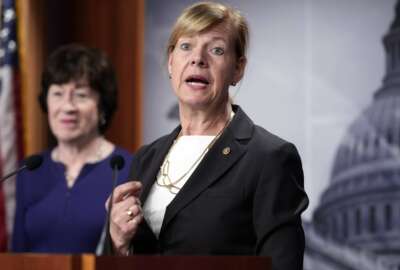Hubbard Radio Washington DC, LLC. All rights reserved. This website is not intended for users located within the European Economic Area.
On Air: Federal News Network
Trending:
Better IT governance helping some agencies reduce duplication
Energy, DHS and DoD CIOs told House lawmakers how each of their agencies is reducing duplicative systems. GAO released its latest report on the IT dashboard and...
wfedstaff | June 4, 2015 5:38 pm
Three of the largest agencies are using improved governance processes to reduce the number of duplicative technology systems.
The Defense Department has developed a three pronged approach to examine new IT projects. Teri Takai, the DoD chief information officer, said the investment review board, the acquisition process and the Defense Business Systems Management Committee have helped reign in decentralized planning and budgeting.
And all three will play larger role starting next year by examining not just new, but also existing IT spending. DoD’s IT budget request for fiscal 2013 is $37.1 billion. 
She said the services already are making progress.
“The Army acquisition domain has reduced the number of IT systems in that portfolio by 41 percent from 2006,” she said. “The logistics modernization program has sunset all 42 instances of the Army’s standard depot system. Additionally, they have sunset all but one instance of the commodity control system. A system comprised of 460 applications.”
Along with the Army, the Navy has reduced by 50 percent the number of applications across 21 functional areas since 2003, and eliminated more than 400 legacy networks over the last three years.
She said the Marine Corps has reduced the number of its applications by approximately 30 percent over the last 18 months. The Air Force Material Command headquarters is looking to terminate outdated systems and duplicative software.
Takai said the acting under secretary of Acquisition, Technology and Logistics Frank Kendall also is reviewing eight logistics systems to figure out how best to consolidate them.
And on top of all of this Takai said the military plans to close 125 more data centers in 2012.
DHS developing standard contracting language
The Energy and Homeland Security departments also starting to see benefits from a revamped governance process to deal with duplication.
The CIOs for each of the agencies told House lawmakers part of the challenge is the decentralized approach to IT procurement and budgeting.
Richard Spires, the DHS CIO, said there are systems he’d like to expand across the agency but contracting language prevents him from doing so. 
Spires said the standard contract language will be used in the new procurements that would make sure this issue doesn’t continue to hamstring DHS.
“We are working in the federal CIO Council with OMB to see if we can come up with standard language that allows us to issue contracts that can be leveraged by other agencies,” he said.
Additionally, DHS is trying to improve acquisition by having a special group of contracting officers work on IT procurements. Agency chief acquisition officer Nick Nayak has placed contracting folks in the IT office to understand and get used to working on technology acquisitions, Spires said.
Energy’s new governance council having an impact
At Energy, CIO Mike Locatis said during the hearing he did a 45-day analysis when he first got to the agency nearly 15 months ago.
From that, Locatis said he identified several opportunities to get rid of duplicative systems, which stemmed from fragmentation of oversight and budget over the years. 
“DoE needed to connect its cybersecurity resources more efficiently across the complex,” he said. “We established the JC3 to take a collaborative approach to cyber information sharing and analysis and incident response across DoE enterprise, and more effectively leverage the technical expertise of our national laboratories. This has made our cyber program stronger and consolidated a number of duplicative functions.”
Locatis also said Energy’s move to a virtual desktop is reducing the number of applications and servers they need, which reduces costs, makes the agency more secure and more energy efficient.
He also said a new unified communication and desktop videoconferencing system will save millions of dollars by reducing the need for travel and better connecting employees.
IT dashboard is helping
All three CIOs credited the Office of Management and Budget’s IT dashboard for helping improve their governance processes and reducing systems.
The Government Accountability Office issued its latest report at the hearing on the effectiveness of the dashboard.
David Powner, GAO’s director of Information Technology Management Issues, said Energy, DHS and DoD have all taken actions to address duplication and they seem to be working.
Takai said the dashboard provides the CIO with several important benefits beyond the tracking and oversight of IT projects.
“The visibility and transparency is important not only for us as CIOs, but actually what we would view as more important is the visibility to the business process owners and the business process changes that have to happen for any IT implementation to be successful,” she said. “The success of these large scale business systems are more around can we change the processes and can we actually make the business changes that we need? The dashboard really brings the opportunity for us to have the dialogue at a much different level than if it was just delegated to being a technology discussion.”
GAO made several recommendations for the three agencies to further reduce duplicative systems, including correcting how they categorize IT investments.
RELATED STORIES:
GAO: IT Dashboard accuracy improving
DHS CIO taking on IT governance
Air Force doubling down on IT efficiencies
Shrinking budgets may be a blessing for DoD IT
Copyright © 2024 Federal News Network. All rights reserved. This website is not intended for users located within the European Economic Area.
Jason Miller
Jason Miller is executive editor of Federal News Network and directs news coverage on the people, policy and programs of the federal government.
Follow @jmillerWFED
Related Topics
-
Don’t look now, but your TSP is swooning Federal Drive
-
DoD gets serious about technology transfer to the troops Federal Drive





